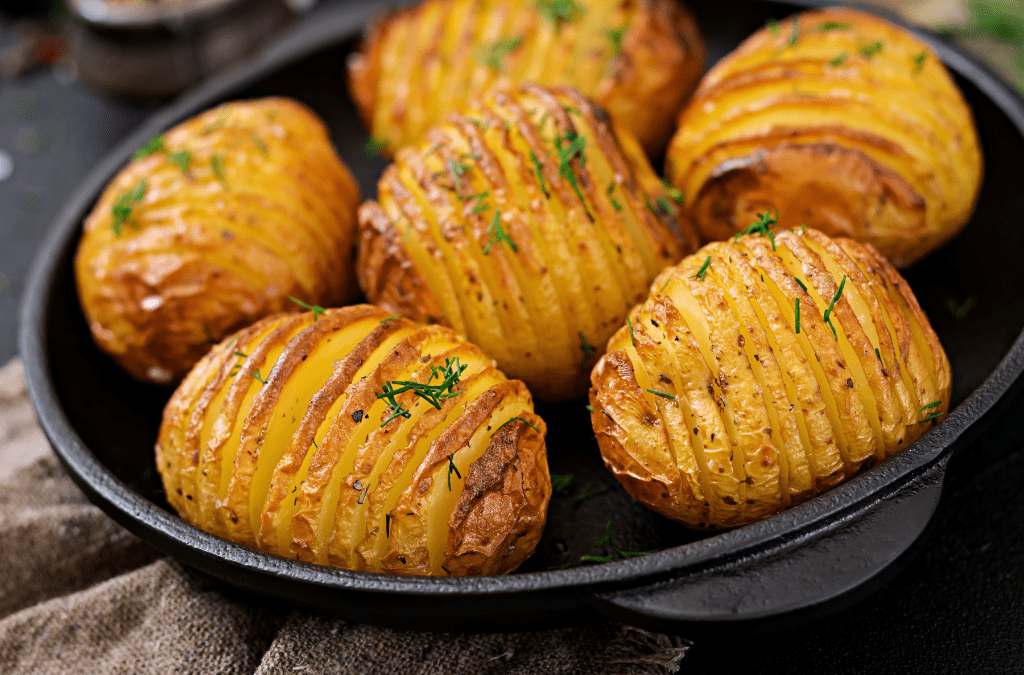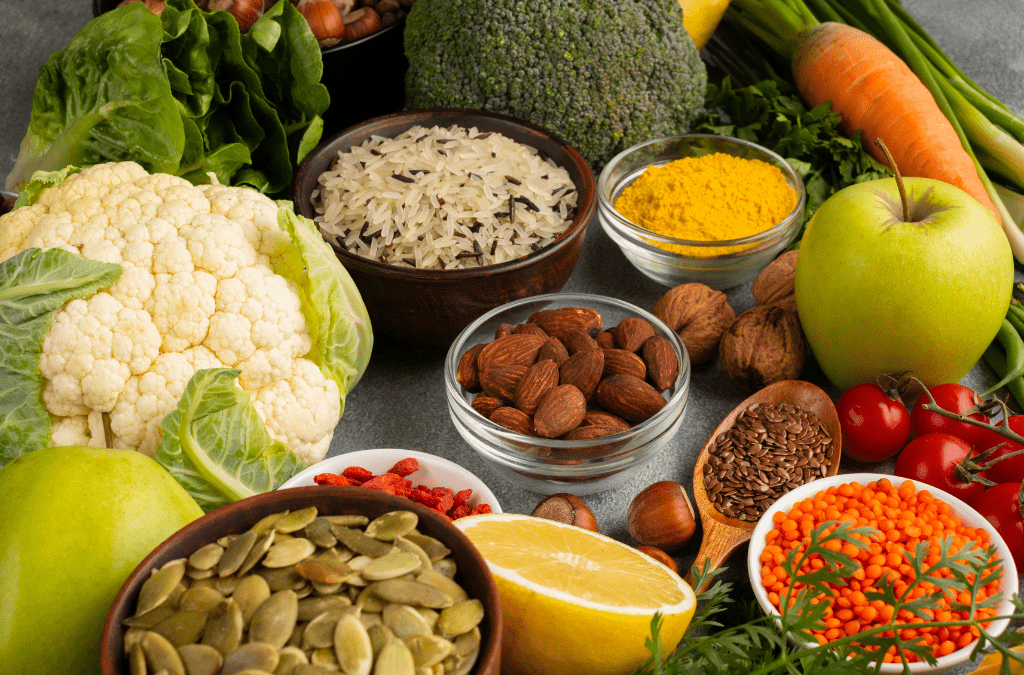
Table of Contents
A Closer Look at This Popular Starchy Side
Russet potatoes, with their brown, netted skin and fluffy white interior, are one of America’s staple side dishes. Baked potatoes are beloved for their versatility; you can load them up with any topping under the sun. Sour cream, cheese, bacon, broccoli—the possibilities are endless.
But potatoes have a reputation for being high in carbohydrates. So how many carbs are in a large baked spud? Should you avoid that loaded potato skin if you’re watching your carb intake? Let’s find out.
What Are Carbohydrates?
Before diving into the carb count of baked potatoes, let’s cover some carb basics. Carbohydrates are one of the three main macronutrients, along with protein and fat, that provide energy to the body. According to the USDA, 37% of Americans fall short on meeting their daily vegetable intake recommendations. Including nutrient-dense potatoes can help fill this veggie gap.
There are three main types of carbohydrates:
- Sugars are found naturally in foods like fruits and milk. Also added to processed foods and drinks. Simple sugars are absorbed quickly for fast energy.
- Starches are found in grains, vegetables, and beans. It provides more sustained energy because it takes longer to break down. Potatoes contain starch.
- Fiber is found in plant foods. It provides bulk but minimal calories and energy because we lack the enzymes to fully break it down.
Carbs get a bad reputation, but they aren’t inherently “unhealthy.” Our brains and muscles rely heavily on carbs as their preferred fuel source. The key is to focus on getting more of your daily carbs from fiber-rich whole food sources.
Why Are Carbs in Potatoes So Controversial?
The carb content of potatoes is controversial for a few reasons:
1. Potatoes Are Starch-heavy
As tubers, potatoes are an abundant source of starch. A medium-size baked russet potato with skin provides approximately 35 grams of carbs, with almost 3 grams coming from fiber, so the rest is starch.
For some low-carb diets, like keto, 35+ grams may be too much for one side dish. But for a more moderate carbohydrate intake, potatoes can still fit into a healthy diet.
2. Potatoes Spike Blood Sugar
Being high in starch means potatoes have a high glycemic index. They cause more rapid spikes in blood sugar compared to lower-glycemic foods. This matters most for diabetics, but some argue potatoes promote poor blood sugar regulation in general.
However, glycemic response depends enormously on preparation methods (more on that below) as well as what foods are eaten alongside them. Eating potatoes alongside protein, fat, and fiber helps blunt the spikes.
3. Potatoes Are High “Calorie-density”
At around 160 calories per medium-sized baked potato, some consider potatoes “high-calorie” vegetables. After loading them up with high-fat toppings, the calorie tally quickly soars.
However, plain potatoes are lower-calorie than most grains. And the calorie cost comes with very nutritious veggie carbs. As always, portion sizes and topping choices are key.
The Case for Potatoes
While they may be starchy, potatoes boast an impressive nutritional profile.
1. Potassium Powerhouse
A large baked potato with skin provides over 900 milligrams of potassium. That’s 20% of the recommended daily intake, making potatoes higher in potassium than a banana. This mineral is essential for heart health, fluid balance, and muscle and nerve function.
2. Packed with Vitamin C
A potato supplies 45% of the RDI for immune-boosting vitamin C. That’s nearly half your daily needs from just one spud. Vitamin C also aids in iron absorption.
3. Supplies Fiber
A large baked potato averages nearly 3 grams of fiber per serving. Fiber has been linked to better digestion, heart health, stabilized blood sugar levels, and healthy weight maintenance.
4. Other Nutrients
Baked potatoes also contain vitamin B6, magnesium, and antioxidants. The skin is the most concentrated source of nutrients, so leaving it on boosts its value.
5. Satisfying and Versatile
And let’s not forget that potatoes are extremely versatile, wallet-friendly, easy to prepare, and satisfying. At a time when many Americans fall short on vegetable intake, potatoes help fill the gap.
So potatoes can most certainly have a place in a healthy diet, even with their carbs and starch. The key is mindful prep methods and reasonable portion sizes.
How Many Carbs Are in a Large Baked Potato?
Now that we’ve established the merits of potatoes for a balanced diet, let’s get specific on nutrition stats…
One large baked potato (299g) with skin contains:
- 37 grams of total carbohydrate
- 3 grams of fiber
- 34 grams of starch or digestible carbs
- 161 calories
So one plain large baked potato will provide you with approximately 34 “net” grams of digestible starch carbs, supplying 137 calories from carbs.
Different Diet Plans to Put Carb Count Into Perspective
1. Standard Diet (45–60% carbs)
Most mainstream healthy eating guidance recommends getting 45–60% of your total daily calories from carbs. This equates to a minimum of 225 grams of carbs per day on a standard 2,000-calorie diet.
A large baked potato with 34 grams of digestible carbs represents just 15% of the daily carb allotment. So it can easily fit into a standard moderate-to-high-carb diet.
2. Low-carb diet (26-45% carbs)
On a low-carb diet providing between 100 and 150 daily carb grams for a 2,000-calorie intake, a large baked russet supplying 34 net carbs would represent 23–34% of total carbs.
This is nearing the upper end for a single food item. But when eating lower carbs overall, fitting in an occasional potato is doable. Prioritizing vegetable carbs over grains or sugar is recommended on low-carb diets.
3. Ketogenic Diet (<5% Carbs)
To achieve ketosis, most people need to keep their net carbs under 50 grams daily. Some can stay in ketosis with carb counts up to 70–100 grams.
Since one large baked potato already provides 34 net carbs, it would be hard to fit in and stay under carb limits on keto. Occasionally, enjoying a small portion of potatoes is possible, but this starchy vegetable is too high in carbs to be a regular thing. Cauliflower mash makes a good sub.
4. Glycemic Index Comparison
As mentioned earlier, potatoes have among the highest GIs for vegetables. But the preparation method drastically impacts the effect on blood sugar.
Here’s how the GI shakes out for a baked russet potato based on cooking method:
- Boiled potato: GI 79 (high)
- Baked potato: GI 111 (very high)
- Mashed potatoes: GI 103 (very high)
- Cooled baked potato: GI 56 (low)
As you can see, a baked, then cooled potato has less than half the GI rating of a piping-hot baked russet! The longer the baking time, the more resistant the starch crystals. Cooling then converts more starch into a resistant form. Other ways to lower potato Glycemic impact:
- Leave the skin on.
- Pair with fats, protein, vinegar, and fiber-rich sides.
- Choose small or medium potatoes over large ones.
How to Make Baked Potatoes Healthier
Baked potatoes can be part of healthy eating when prepared mindfully. Here are some easy ways to keep spuds nutrient-dense:
1. Bake, Don’t Fry
Baking potatoes preserves more nutrients than frying. Frying also adds significant calories from oil absorption. Go for oven-baked potatoes instead of French fries or hash browns.
2. Keep the Skin On
Much of a potato’s fiber and nutrients are found in the skin. Leaving it on your baked potato helps lower the GI impact while boosting nutrition. Crispy baked skins are delicious too!
3. Make ‘Em Mini
Choose small or medium-size potato varieties to help control portions. Or cut a large potato in half. This further lowers the glycemic load per serving.
4. Top Smart
Skip high-fat, high-sodium toppings like bacon, butter, and sour cream and opt for veggie-based topping options instead. Broccoli, salsa, beans, spinach, caramelized onions, mushrooms, and even an egg white are all nutritious additions. Greek yogurt or avocado supply healthier fats.
5. Watch Portions
Stick to one medium-large potato at a meal, and round out your plate with lower-carb veggies and protein foods to balance. Leftover baked potatoes keep well for next-day meals.
6. Add Vinegar
Splash your loaded baked potato with hot sauce or apple cider vinegar. Studies show vinegar lowers a food’s glycemic response. The acetic acid slows the digestion of carbs.
7. Make a Potato Salad
Chilled, diced potatoes have highly resistant starch. Using a vinaigrette dressing on your potato salad lowers GI impact even further thanks to the vinegar.
How Low Can You Go?
As we’ve discovered, russet potatoes offer around 34 grams of digestible carbs per large spud. But tiny new potatoes contain about half the carbs, clocking in at around 15-20 grams per potato. Petite varieties to consider:
1. Baby New Potatoes
These tiny young spuds measure 1-2 inches across. A 6-ounce baked serving contains 19 grams of carbs. Their thinner skin means higher nutrient density.
2. Fingerling Potatoes
Slightly larger than new potatoes at 3–4 inches long, baked fingerlings have around 20 grams of carbs per 5-ounce serving. They come in hues like purple, yellow, and red with creamy flesh.
3. Mini Sweet Potatoes and Standard Sweet Potatoes
Range from 30 to 40 grams in carbs. But mini versions only have 18 grams of carbs when baked for a 3-ounce potato. They’re about the size of a plum.
Tips for Serving Low-Carb Spuds
- Toss roasted fingerlings or new potatoes with garlic oil and herbs for an easy side.
- Stuff baked mini sweet potatoes with spinach and feta.
- Make potato salad with baby potatoes, Greek yogurt dressing, and lots of veggies.
Conclusion
So how many carbs should you budget for a large baked potato? A good general guideline is around 30-35 net carb grams per average-size spud. But many factors impact the numbers, including size, prep methods, toppings, and sides.
While they can’t be considered low-carb, potatoes still bring ample nutrition to the table. When prepared thoughtfully and enjoyed in moderate portions, potatoes can be part of an overall balanced, healthy diet for many people. Don’t ban the spuds! Instead, bake ‘em right, keep reasonable expectations for portions, and pair with lower-carb veggies for a fiber-, vitamin-, and mineral-packed plant-based meal.







